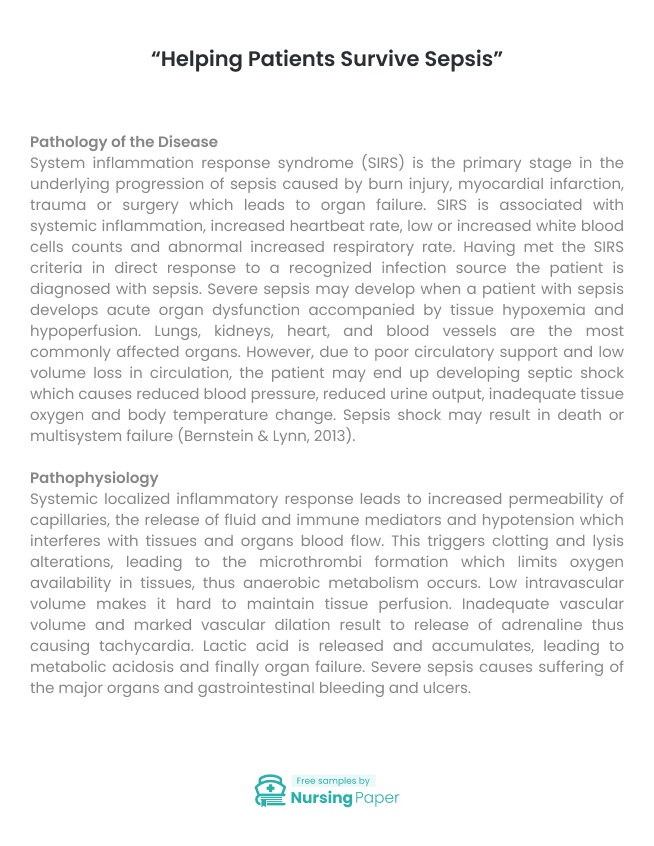
Helping Patients Survive Sepsis
Pathology of the Disease
System inflammation response syndrome (SIRS) is the primary stage in the underlying progression of sepsis caused by burn injury, myocardial infarction, trauma or surgery which leads to organ failure. SIRS is associated with systemic inflammation, increased heartbeat rate, low or increased white blood cells counts and abnormal increased respiratory rate. Having met the SIRS criteria in direct response to a recognized infection source the patient is diagnosed with sepsis. Severe sepsis may develop when a patient with sepsis develops acute organ dysfunction accompanied by tissue hypoxemia and hypoperfusion. Lungs, kidneys, heart, and blood vessels are the most commonly affected organs. However, due to poor circulatory support and low volume loss in circulation, the patient may end up developing septic shock which causes reduced blood pressure, reduced urine output, inadequate tissue oxygen and body temperature change. Sepsis shock may result in death or multisystem failure (Bernstein & Lynn, 2013).
Pathophysiology
Systemic localized inflammatory response leads to increased permeability of capillaries, the release of fluid and immune mediators and hypotension which interferes with tissues and organs blood flow. This triggers clotting and lysis alterations, leading to the microthrombi formation which limits oxygen availability in tissues, thus anaerobic metabolism occurs. Low intravascular volume makes it hard to maintain tissue perfusion. Inadequate vascular volume and marked vascular dilation result to release of adrenaline thus causing tachycardia. Lactic acid is released and accumulates, leading to metabolic acidosis and finally organ failure. Severe sepsis causes suffering of the major organs and gastrointestinal bleeding and ulcers. The drug metabolism rate is lowered due to inadequate liver perfusion resulting in cell death and increased liver enzyme levels. There may be an acute renal failure as kidney increase sensitivity to hypoperfusion (Bernstein & Lynn, 2013).


Nursing, Medical Management and Patient Centered Management
Information on early signs and symptoms of sepsis is necessary during nursing practice, such as assessment to prevent septic shock and assure immediate treatment before ICU admission of the patient. The assessment includes changes in heart rate, mental status, and oxygenation and tissue perfusion; this information is useful in detecting organ failure. Blood pressure readings in sepsis patients assist in planning care and nursing assessment. Sepsis patient measurement of urine output is necessary as it reflects renal hypoperfusion. The components of nursing care plans include diagnosis, assessment, expected outcome, interventions and evaluation. For patient-centered medical management, slight changes in patient’s status should be reported which provides for physical signs of SIRS together with the patients’ history consistency with infection (Bernstein & Lynn, 2013). Signs and symptoms of hypotension should be reported promptly. Sepsis intervention at early stages includes the use of antibiotics and hydration .effective management of the circulatory problems caused by sepsis is necessary to prevent organ failure. For treatment of severe sepsis, patients require proper prescription with fluid resuscitation. The urinary catheter is used to assist in the faster restoration of intravascular volume. Monitoring of the central venous pressure is essential in delivering additional information in patients suspected with hypotension to guide on fluid resuscitation. Early diagnosis of SIRS and immediate treatment helps to reduce sepsis death. As a nurse one should play an essential role in preventing a patient from becoming acutely ill with sepsis by preventing drops in blood pressure, ensuring various infections treatment and sustenance of vital organs. The patient should also undergo other forms of treatment such as respiratory, kidney dialysis and surgery where necessary to do away with an infection (Robson & Daniels, 2008).
1. Bernstein, M., & Lynn, S. J. (2013). Helping patients survive sepsis. American Nurse Today, 8(1), 24-29.
2. Robson, W. P., & Daniels, R. (2008). The Sepsis Six: Helping patients to survive sepsis. British Journal of Nursing, 17(1), 16-21.



The download will start shortly.

The download will start shortly.
 Subject:
Nursing
Subject:
Nursing  Number of pages: 7
Number of pages: 7  Subject:
Medicine
Subject:
Medicine  Number of pages: 2
Number of pages: 2  Subject:
Health and Social Care
Subject:
Health and Social Care  Number of pages: 4
Number of pages: 4  Subject:
Nursing
Subject:
Nursing  Number of pages: 3
Number of pages: 3  Subject:
Medicine
Subject:
Medicine  Number of pages: 7
Number of pages: 7  Subject:
Health and Social Care
Subject:
Health and Social Care  Number of pages: 7
Number of pages: 7  Subject:
Health and Social Care
Subject:
Health and Social Care  Number of pages: 2
Number of pages: 2  Subject:
Nursing
Subject:
Nursing  Number of pages: 5
Number of pages: 5  Subject:
Medicine
Subject:
Medicine  Number of pages: 18
Number of pages: 18  Subject:
Medicine
Subject:
Medicine  Number of pages: 3
Number of pages: 3  Subject:
Nursing
Subject:
Nursing  Number of pages: 5
Number of pages: 5  Subject:
Medicine
Subject:
Medicine  Number of pages: 13
Number of pages: 13  Subject:
Medicine
Subject:
Medicine  Number of pages: 9
Number of pages: 9  Subject:
Health and Social Care
Subject:
Health and Social Care  Number of pages: 3
Number of pages: 3  Subject:
Nursing
Subject:
Nursing  Number of pages: 4
Number of pages: 4 
